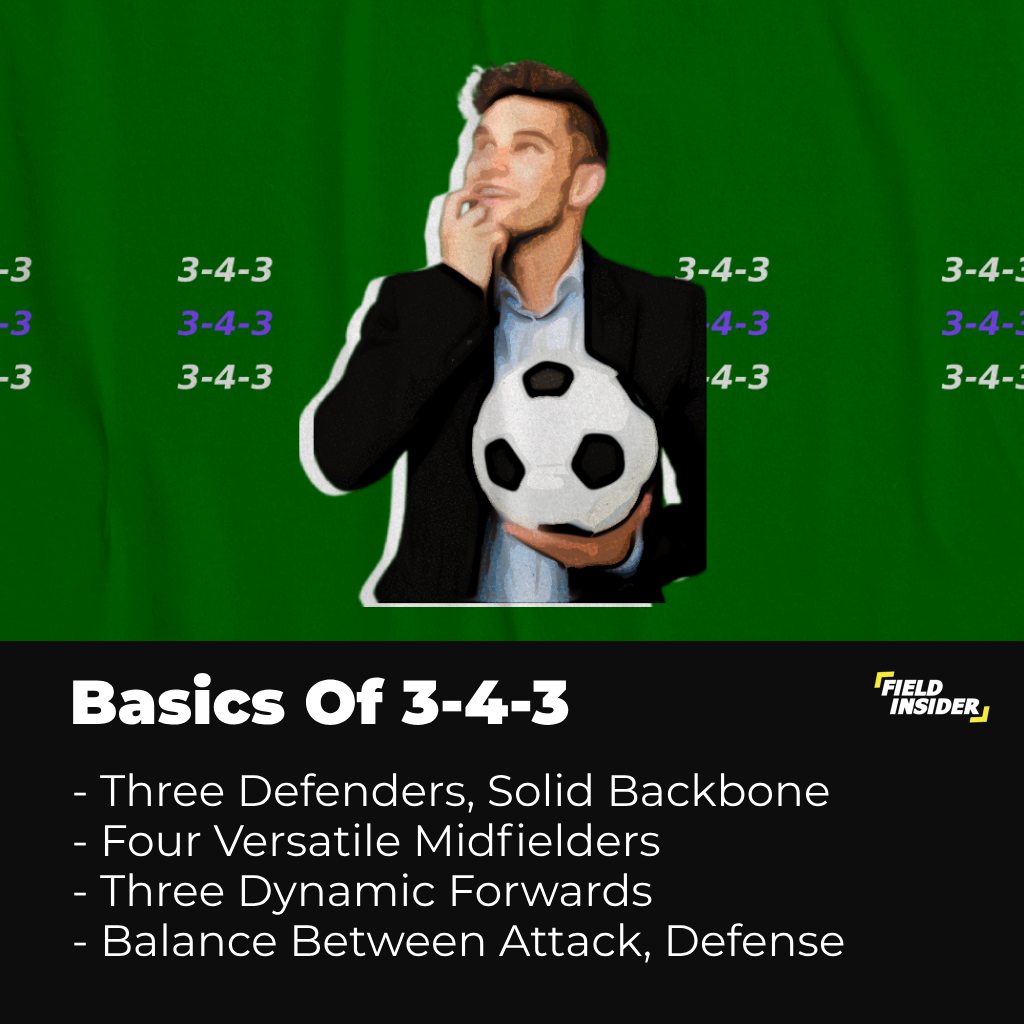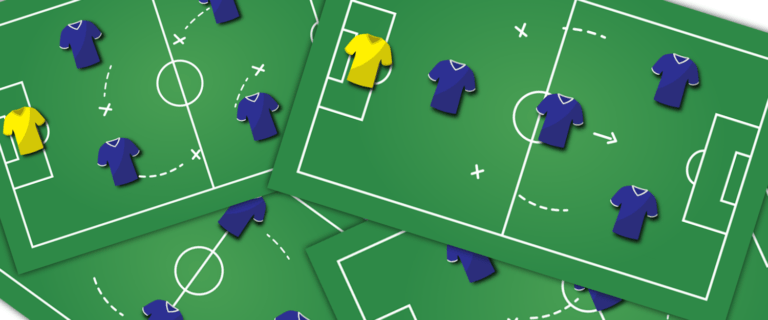The 3-4-3 Formation: Complete Handbook
In the ever-evolving landscape of soccer tactics, the 3-4-3 formation stands out as a testament to the game’s dynamic nature, balancing defensive security with attacking prowess.
This formation, characterized by three defenders, four midfielders, and three forwards, offers teams a versatile framework to exploit the width of the pitch while maintaining a solid defensive structure.

Through a deep dive into the basics, advantages, training tips, and future trends, this article aims to provide an insightful exploration of the 3-4-3 formation.
Key Takeaways
| Key Topics | Key Takeaways |
|---|---|
| Understanding the Basics | Emphasizes formation layout, player positioning, and historical evolution. |
| Tactical Analysis | Focuses on strengths, weaknesses, and comparison with other formations. |
| Player Profiles and Attributes | Identifies essential attributes for each position within the 3-4-3 system. |
| Advantages of the 3-4-3 Formation | Highlights enhanced width, balanced support, and tactical adaptability. |
| Disadvantages of the 3-4-3 Formation | Outlines vulnerabilities to counter-attacks, player demands, and coordination complexity. |
| Training and Coaching Tips | Offers strategies for implementation, including tailored drills and coaching insights. |
| Match Analysis | Provides real-life case studies and lessons from employing the 3-4-3 formation. |
| Future Trends and Adaptations | Discusses potential developments, influences of modern tactics, and predictions. |
Understanding the Basics

Expanded Formation Layout and Positioning of Players
The 3-4-3 setup is a balanced blend of defense, midfield, and attack, necessitating precise player positioning to maintain this equilibrium. This structure is pivotal for both offensive thrusts and defensive solidity.
Mastery in positioning is essential, as it forms the crux of the formation’s effectiveness. Detailed strategies and positioning guides can be further explored in our detailed analysis on soccer formations.
In-depth Roles and Responsibilities within the Formation
In the 3-4-3 framework, each player’s role is meticulously defined, from the defensive trio to the attacking front line. The defenders guard against breaches, midfielders link play and maintain possession, while forwards execute the final assaults.
A thorough comprehension of these responsibilities is crucial for the system’s success. For more on individual and collective roles, delve into our comprehensive breakdown on teamwork in soccer.
Historical Context and Evolutionary Path of the 3-4-3 Formation
The journey of the 3-4-3 formation through soccer’s history underscores its adaptability and strategic depth. Originating from more rigid setups, it has evolved in response to the dynamic nature of modern football, offering tactical flexibility and innovation.
This historical progression highlights the shift towards multifaceted playing styles, a transition captured in our feature on the evolution of soccer tactics formation evolution.
Tactical Analysis
Comprehensive Examination of the 3-4-3 Formation’s Strengths and Weaknesses
The 3-4-3 system is celebrated for its equilibrium between a potent attack and a steadfast defense, enabling teams to exploit wide areas while maintaining a solid backline.
However, this balance comes with its set of challenges, particularly when facing fast-paced counter-attacks or attacks down the wings. To counter these potential pitfalls, a team must excel in rapid transitions. Insights into these dynamics can be gained from our exploration of defensive and attacking formations.
Detailed Comparison with Other Prominent Soccer Formations
Contrasting the 3-4-3 with other formations such as the 4-4-2 and the 5-3-2 reveals its unique tactical benefits and potential drawbacks. The 3-4-3 offers unmatched midfield control and attacking breadth, yet demands high levels of stamina and coordination from its players.
Mastery over the nuances of each formation equips teams to capitalize on their inherent strengths while neutralizing their weaknesses, as dissected in our comprehensive review of popular soccer formations.
Strategic Adjustments and Tailored Variations within the 3-4-3 Framework
The 3-4-3 formation’s inherent versatility permits a range of tactical shifts to adapt to evolving game scenarios and exploit opponents’ weaknesses.
These modifications can alter the team’s approach from defensive conservatism to all-out attack, depending on the match’s demands and the players’ capabilities.
Player Profiles and Attributes
Ideal Player Profiles for Each Position in the 3-4-3 Formation
Success in the 3-4-3 configuration demands players with specific skill sets tailored to their roles. Defenders must combine speed with tactical awareness, midfielders require exceptional stamina and ball-handling abilities, and forwards should exhibit versatility and precision.
Understanding the ideal player profile for each position ensures the formation’s effectiveness, a topic thoroughly explored in our detailed guide on soccer player roles.
Key Attributes Required for Success in the 3-4-3 System
The 3-4-3 system thrives on players possessing a blend of physical, technical, and mental attributes. Defenders need to be vigilant and robust, midfielders should exhibit endurance and creativity, and forwards must be agile and lethal.
For a comprehensive understanding of these essential attributes, delve into our analysis of essential football skills.
Notable Players and Teams Known for Utilizing the 3-4-3 Formation Effectively
The 3-4-3 formation has been effectively employed by notable teams and players, showcasing its versatility and tactical depth.
| Team/Player | Season/Event | Role/Contribution |
|---|---|---|
| Chelsea (Antonio Conte) | 2016-2017 Premier League | Transformed Chelsea into champions with a solid 3-4-3 |
| Belgium (Roberto Martínez) | 2018 FIFA World Cup | Achieved third place using a dynamic 3-4-3 |
| Inter Milan (Antonio Conte) | 2019-2020 Serie A | Challenged for the title with a versatile 3-4-3 |
| Eden Hazard | Chelsea, 2016-2017 | Key forward in Chelsea’s 3-4-3, contributing goals and assists |
| N’Golo Kanté | Chelsea, 2016-2017 | Midfield dynamo, crucial for the formation’s balance |
| Kevin De Bruyne | Belgium, 2018 FIFA World Cup | Central figure in Belgium’s 3-4-3, master of midfield play |
Analyzing the Impact: Forwards’ Performance in the 3-4-3 Formation
The accompanying chart offers a concise visual summary derived from a recent study, “The influence of tactical formation on physical and technical match performance in professional soccer” , focusing on the performance metrics of soccer forwards.

The chart indicates that forwards typically engage in ball-possession phases about 60 times per match, underlining their critical role in controlling the game’s flow. With dribbling being a key skill for forwards, the median count just above 2 suggests selective but potentially impactful maneuvers.
The distribution of passes—categorized as short, middle, and long—reveals a strategic preference for maintaining possession and building attacks, as short and middle passes together vastly outnumber long-range passes.
These findings illuminate the tactical nuances and responsibilities of forwards within the 3-4-3 system, contributing to a deeper understanding of their contribution to the team’s overall strategy.
Advantages of the 3-4-3 Formation

Enhanced Width and Offensive Capabilities
The 3-4-3 formation naturally provides teams with significant width, facilitating expansive play and greater offensive options along the flanks.
This setup allows for effective utilization of wing-backs, creating numerical advantages in attack and stretching the opposition’s defense. For an in-depth exploration of this advantage, see our analysis of wide attacking strategies.
Balanced Defensive and Midfield Support
Employing three dedicated central defenders in the 3-4-3 system offers a solid defensive foundation. Similarly, the four midfielders ensure both stability and support in the center of the park.
This balance between defense and midfield contributes to better ball control and helps in effectively transitioning from defense to attack. Insights into achieving this balance can be found in our guide to defensive and midfield coordination.
Flexibility and Tactical Adaptability
The 3-4-3 is highly adaptable, allowing teams to modify their approach based on the game’s demands without needing substitutions. It can transition into more defensive or offensive formations as the situation warrants.
This tactical flexibility is crucial for responding to the flow of the match and opponent strategies, thoroughly discussed in our overview of tactical flexibility in soccer.
Disadvantages of the 3-4-3 Formation
Vulnerability to Counter-Attacks and Wide Exploitation
The 3-4-3 formation can expose teams to counter-attacks by leaving spaces on the flanks. This vulnerability requires quick adaptation and solid defensive coordination to mitigate risks.
For strategies on countering this weakness, explore our insights on defending against counter-attacks.
High Physical and Tactical Demands on Players
This formation places significant physical and tactical demands on the players, particularly the wing-backs, who are required to contribute both offensively and defensively.
Maintaining high stamina and tactical awareness throughout the match is crucial. It is a challenge discussed in detail in our guide on player fitness and tactical training.
Complexity in Role Definitions and Team Coordination
The 3-4-3 system requires clear understanding and execution of complex roles, necessitating high levels of team coordination and individual player discipline. Misunderstandings or lapses can lead to defensive gaps or missed offensive opportunities.
Training and Coaching Tips

Drills and Exercises Tailored for the 3-4-3 Formation
Implementing the 3-4-3 formation effectively requires specific drills and exercises designed to enhance understanding and execution of this system.
| Drill Type | Objective | Key Focus |
|---|---|---|
| Wing-Back Overlaps | Enhance understanding of wing-back roles and movements | Positioning, timing of runs, crossing, and defending |
| Midfield Rotation | Improve midfielders’ spatial awareness and fluidity | Ball control, passing accuracy, spatial rotation |
| Forward Link-Up Play | Foster cohesion among attacking trio | Communication, movement off the ball, finishing |
| Defensive Shape Practice | Solidify the back three’s understanding and positioning | Defensive organization, communication, zonal marking |
| Transition Drills | Simulate quick switches from defense to attack | Speed, decision-making, positioning, counter-attacking |
| Set Piece Training | Optimize set-piece strategies fitting the 3-4-3 structure | Tactical awareness, execution of set-pieces |
Strategies for Implementing the Formation in Practice Sessions
Adopting the 3-4-3 formation in practice sessions involves strategic planning and execution. Coaches must ensure that players grasp their roles within the formation and the overall team strategy.
This includes emphasizing the importance of positional flexibility and teamwork. For a deeper understanding of implementing complex strategies, refer to our insights on soccer coaching techniques.
Match Analysis
Belgium at the 2018 FIFA World Cup
- Strategic Application: Belgium’s national team, coached by Roberto Martínez, utilized the 3-4-3 to capitalize on their wealth of attacking talent, including Eden Hazard, Kevin De Bruyne, and Romelu Lukaku. This formation helped Belgium finish third, their best ever World Cup performance.
- Key Success: The formation allowed Belgium to transition quickly from defense to attack, using the speed and dribbling of Hazard and the vision of De Bruyne to break through defenses.
- Lesson Learned: Belgium’s performance demonstrated that the 3-4-3 is not only effective in club football but can also be adapted to international play, where teams have less time to gel.
Chelsea under Antonio Conte (2016-2017 Premier League Season)
- Tactical Mastery: Conte’s Chelsea famously adopted the 3-4-3 formation early in the season, leading to a 13-game winning streak and ultimately, the Premier League title. The formation maximized the attacking potential of Eden Hazard and Pedro, while also solidifying the defense.
- Key Success: The width provided by Marcos Alonso and Victor Moses as wing-backs was crucial, allowing Chelsea to stretch opponents and create space. N’Golo Kanté and Nemanja Matić provided the midfield engine, balancing defensive duties with support to the attack.
- Lesson Learned: The success of the 3-4-3 at Chelsea highlighted the importance of player adaptability and the value of a tactically flexible system that can be adjusted based on the team’s strengths and weaknesses.
Future Trends and Adaptations

Anticipating the Evolution and New Approaches
The ongoing evolution of the 3-4-3 formation is set to embrace innovative tactics and player skills, shaping its future applications and strategic nuances. Anticipated developments may involve nuanced player roles or dynamic playing styles, adapting to the changing landscape of football.
Analyzing the Impact of Contemporary Tactics and Evolving Player Roles
The impact of modern tactical approaches and the continuous evolution of player roles are reshaping the traditional 3-4-3 setup. The integration of roles like inverted wing-backs and the increased tactical flexibility are testament to this change.
To stay updated with these transformative trends, delve into our comprehensive discussion on the interplay between current tactics and player developments evolving soccer roles.
Forecasting the Long-Term Viability and Adaptations
The future of the 3-4-3 formation in soccer hinges on its adaptability to new trends, tactics, and player abilities. Its long-term viability will be influenced by its ability to counteract emerging strategies and accommodate innovative playing styles.
Conclusion
In conclusion, the 3-4-3 soccer formation offers a balanced structure with the potential for robust defense and dynamic attacking options. By understanding the roles, strengths, weaknesses, and necessary player attributes, teams can leverage this formation to great effect.
Coaches and players should remain adaptable, continuously evolving their strategies to match the game’s demands. The 3-4-3 is more than just a formation; it’s a framework for creativity, adaptability, and tactical intelligence in the modern game.








